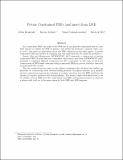Private Constrained PRFs (and More) from LWE
Author(s)
Brakerski, Zvika; Tsabary, Rotem; Vaikuntanathan, Vinod; Wee, Hoeteck
DownloadAccepted version (489.5Kb)
Open Access Policy
Open Access Policy
Creative Commons Attribution-Noncommercial-Share Alike
Terms of use
Metadata
Show full item recordAbstract
© 2017, International Association for Cryptologic Research. In a constrained PRF, the owner of the PRF key K can generate constrained keys K_f that allow anyone to evaluate the PRF on inputs x that satisfy the predicate f (namely, where f(x) is “true”) but reveal no information about the PRF evaluation on the other inputs. A private constrained PRF goes further by requiring that the constrained key K_f hides the predicate f. Boneh, Kim and Montgomery (EUROCRYPT 2017) recently presented a construction of private constrained PRF for point function constraints, and Canetti and Chen (EUROCRYPT 2017) presented a completely different construction for more general NC1 constraints. In this work, we show two constructions of LWE-based constraint-hiding constrained PRFs for general predicates described by polynomial-size circuits. The two constructions are based on two distinct techniques that we show have further applicability, by constructing weak attribute-hiding predicate encryption schemes. In a nutshell, the first construction imports the technique of modulus switching from the FHE world into the domain of trapdoor extension and homomorphism. The second construction shows how to use the duality between FHE secret-key/randomness and ABE randomness/secret-key to construct a scheme with dual use of the same values for both FHE and ABE purposes.
Date issued
2017Department
Massachusetts Institute of Technology. Computer Science and Artificial Intelligence Laboratory; Massachusetts Institute of Technology. Department of Electrical Engineering and Computer SciencePublisher
Springer International Publishing
Citation
Brakerski, Zvika, Tsabary, Rotem, Vaikuntanathan, Vinod and Wee, Hoeteck. 2017. "Private Constrained PRFs (and More) from LWE."
Version: Author's final manuscript
ISSN
0302-9743
1611-3349